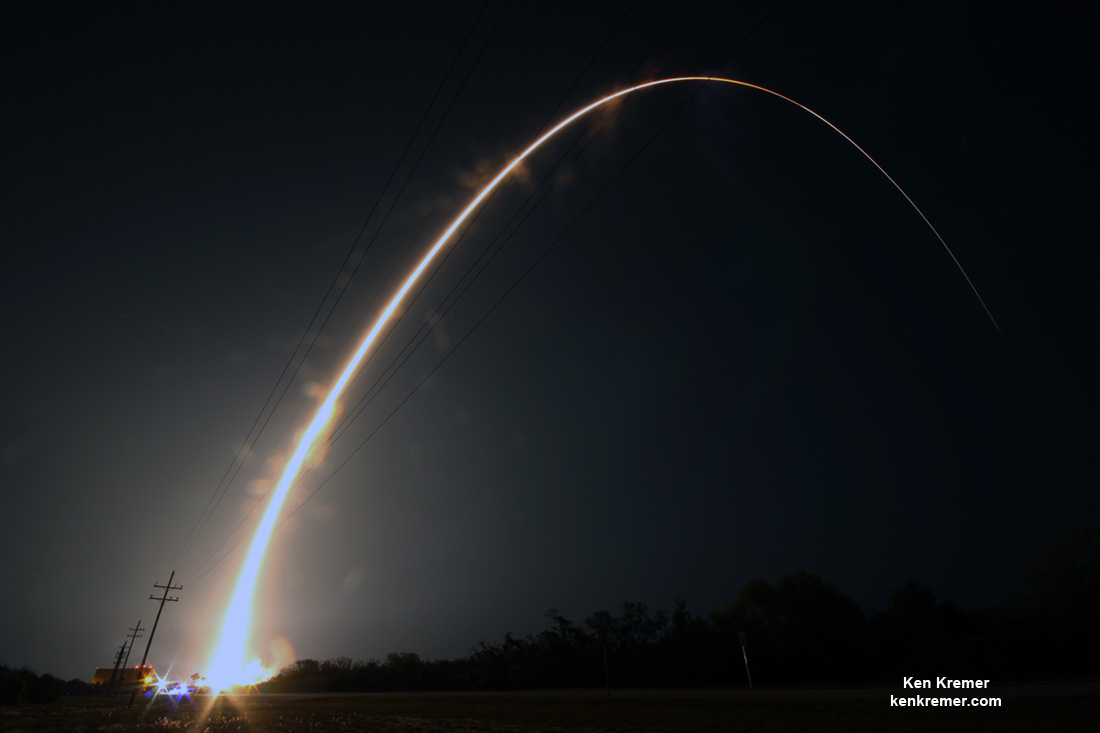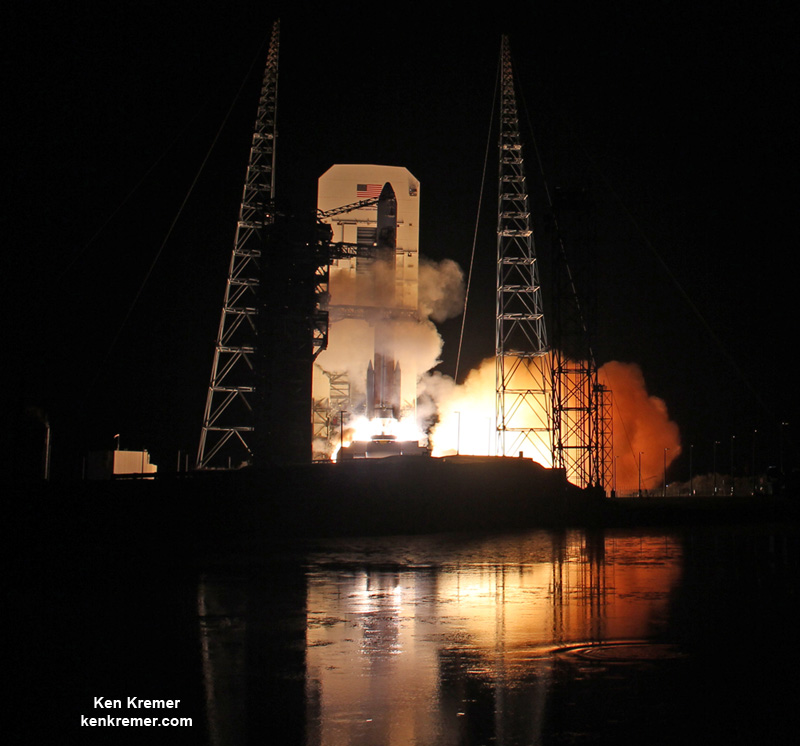
ULA Delta IV rocket streaks to orbit carrying the Wideband Global SATCOM (WGS-9) tactical communications satellite for the U.S. Air Force and international partners from Cape Canaveral Air Force Station, Fl, at 8:18 p.m. EDT on Mar. 18, 2017, in this long exposure photo taken on base. Credit: Ken Kremer/kenkremer.com
CAPE CANAVERAL AIR FORCE STATION, FL - On the 70th anniversary year commemorating the United States Air Force, a ULA Delta IV rocket put on a daunting display of nighttime rocket fire power shortly after sunset Saturday, March 19 - powering a high speed military communications satellite to orbit that will significantly enhance the targeting firepower of forces in the field; and was funded in collaboration with America's strategic allies.
The next generation Wideband Global SATCOM-9 (WGS-9) military comsat mission for the U.S. Force lifted off atop a United Launch Alliance (ULA) Delta IV from Space Launch Complex-37 (SLC-37) on Saturday, March 18 at 8:18 p.m. EDT at Cape Canaveral Air Force Station, Florida.
The launch and separation of the payload form the Delta upper stage was "fully successful," said Major General David D. Thompson, Vice Commander Air Force Space Command, Peterson Air Force Base, CO, to our media gaggle soon after launch at the press view site on base.
"The WGS-9 mission is key event celebrating the 70th anniversary of the U.S. Air Force as a separate service. The USAF was created two years after World War II ended."
"The theme of this year is 'breaking Barriers.'"
WGS-9 was delivered to a supersynchronous transfer orbit atop the ULA Delta IV Medium+ rocket.
The WGS-9 satellite was paid for by a six nation consortium that includes Canada, Denmark, Luxembourg, the Netherlands amd the United States. It joins 8 earlier WGS satellite already in orbit.
"WGS-9 was made possible by funding from our international partners," Thompson emphasized.

Ignition and liftoff of the United Launch Alliance (ULA) Delta IV rocket carrying the WGS-8 highest capacity satcom to orbit for the U.S. Air Force at 6:53 p.m EDT on Dec. 7, 2016 from Cape Canaveral Air Force Station, Fl. Credit: Ken Kremer/kenkremer.com
It is the ninth satellite in the WGS constellation that serves as the backbone of the U.S. military's global satellite communications.

ULA Delta IV rocket poised for sunset blastoff with the Wideband Global SATCOM (WGS-9) mission for the U.S. Air Force from Cape Canaveral Air Force Station, Fl, on Mar. 18, 2017. Credit: Ken Kremer/kenkremer.com
"WGS provides flexible, high-capacity communications for the Nation's warfighters through procurement and operation of the satellite constellation and the associated control systems," according to the U.S. Air Force.
"WGS provides worldwide flexible, high data rate and long haul communications for marines, soldiers, sailors, airmen, the White House Communication Agency, the US State Department, international partners, and other special users."
WGS-9 also counts as the second of at least a trio of launches from the Cape this March - with the possibility for a grand slam fourth at month's end - if all goes well with another SpaceX Falcon 9 launch from pad 39A.
Stay tuned here for Ken's continuing Earth and planetary science and human spaceflight news.
Ken Kremer

Close-up view of nose cone encapsulating the Wideband Global SATCOM (WGS-9) mission for the U.S. Air Force slated to launch from Cape Canaveral Air Force Station, Fl, on Mar. 18, 2017. Credit: Ken Kremer/kenkremer.com
No comments:
Post a Comment